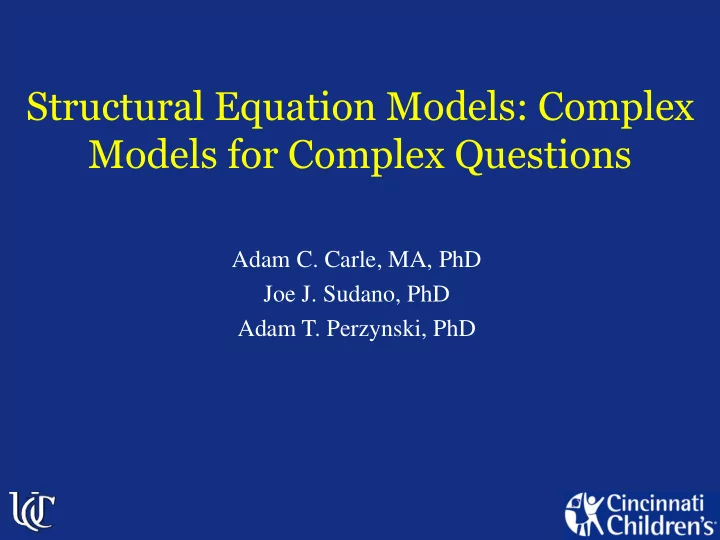

Structural Equation Models: Complex Models for Complex Questions Adam C. Carle, MA, PhD Joe J. Sudano, PhD Adam T. Perzynski, PhD
Today • Brief introduction to structural equation modeling concepts. • Two detailed presentations. – Drs. Sudano and Perzynski. • Time for questions.
A Bit About Me
Introduction • The success of health services research depends on the measures and methods used. • Structural equation models – SEM. • Use a set of equations to model the relationships among a set of variables.
Why SEM? • How might one test this entire model?
Why SEM? • Ability to study complex relationships among multiple variables. – Some directly observed. – Others indirectly observed. – None measured without error. • Simultaneously examine the relationships among several variables. – Test directionality. – Test timing of effects.
Why SEM? • Ability to more accurately study and include indirectly observed variables in analyses. – Use a series of questions to measure an indirectly observed variable. • No single question perfectly measures a construct. – Using a set of questions increases the accuracy with which one estimates individuals’ levels of the variable.
Measurement Model
Measurement Model • SEM “partials out” random measurement error and allows for more accurate estimation of relationships among variables. – Random measurement error typically attenuates the true size of correlations. • Effect sizes often small in social sciences. – Attenuation makes it more difficult to observe and understand true effects. – SEM increases study’s power. • SEM can model more complex forms of measurement error too.
Measurement and Structure
“Structure” • Structure is (in essence) specifying how the variables in the model relate to one another. • One can test and compare the fit of competing models. – Also called causal modeling (partly) because of this. • Example: – Hospital level factors predict patients’ outcomes. – Nurse level factors predict patients’ outcomes. • Hospital level factors are limited by nurse level. – Patient level factors predict patients’ outcomes. • Hospital and nurse level factors are limited by patient level factors.
Measurement and Structure υ Λ η Γ x ε * Y i y i y i i η α Γ x Β η ζ i i i i
Hold the Horses….. You promised no equations!
Measurement & Structure
An Alternate Specification
Longitudinal Research • SEM offers tremendous advantages in longitudinal research. • Trajectories of change. – How do one or more variables change across time? • Mediation is a critical topic in HSR. – What is the mechanism that causes a relationship between two variables? – To answer fully, one needs longitudinal data.
Mediation • Simplified diagram of mediation in SEM.
Longitudinal Growth Models • Simplified path model of longitudinal growth analysis in SEM.
Multilevel SEM • Much of the data in HSR is clustered data. – Patients clustered within providers. – Providers clustered within centers. – Centers clustered within geographic areas. • The concepts discussed so far remain relevant, but now can be considered at all levels. – A set of items may measure constructs differently across levels. – Growth can occur at both levels. • And differentially.
Multilevel SEM y1 Average individual response. y1 Average county response. y1 y2 y2 y2 y2 y3 y3 y3 y3 y4 y4 y2 y4 County Individual Access Access y5 y5 y5 y5 Individual-Level County-Level
Categorical Latent Variables? • So far, we have only discussed continuous latent variables. • Recent advances in SEM have combined mixture models and structural equation models. – Second generation SEM. • Recent advances in SEM have combined mixture models and structural equation models. – Second generation SEM.
Factor Mixture Model
Factor Mixture Model F C
Categorical Latent Variables? • Growth mixture models. – Combine growth model • Trajectory. – With mixture model • Categorical latent variable. – Model different growth trajectories across latent subgroups.
Conclusions
Conclusions • SEM offers the HSR a tremendous tool to more accurately, powerfully, and fully investigate key research questions. – Opportunity to shed the untenable assumptions underlying the use of only directly observed data. – Flexible framework. – Ability to more powerfully evaluate complex questions and data. • We’ve barely scratched surface of SEM’s potential. • Drs. Sudano and Perzynski will present two detailed examples.
Recommend
More recommend